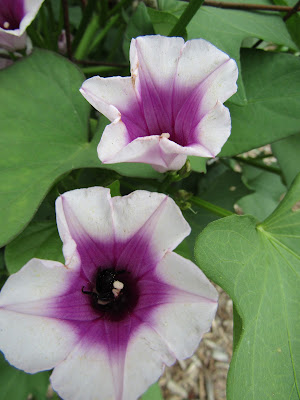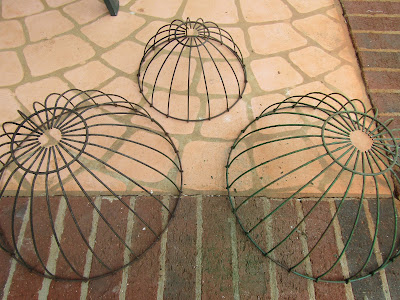Yesterday we woke up to 61 degrees,
and enjoyed a cool breeze most of the day.
It seems that fall may be arriving a bit early.
You won't get one complaint from me!
and enjoyed a cool breeze most of the day.
It seems that fall may be arriving a bit early.
You won't get one complaint from me!
With autumn hinting at staying a while,
it seemed like a great time to do some clean up in the garden.
The ride-on tractor and little trailer are so helpful
and save me lots of steps.
The leaf pile sits in a corner of our side yard
and holds last autumn's bounty.
It breaks down over the year and is then used
to amend the beds.
Leaf mulch tends to attract earthworms and other beneficial organisms,
which will enrich your growing medium.
It can also act as an aerator and balances out the nitrogen in soil.
When grabbing a forkful from our pile,
there were tons of these lil' critters doing their work.
The remainder of any spring/summer veg was pulled from the hugelkultur bed,
except for some leek, basil and nasturtiums.
When I get to planting in earnest,
these can continue growing without being in my way.
The shredded leaves were added to the bed,
along with some fresh soil, compost, and worm castings from our worm bin.
I also decided to remove most of the larger logs from the bottom of the bed.
Since they hadn't broken down that much in a year,
I will save them for future beds that will be a bit deeper.
Since they hadn't broken down that much in a year,
I will save them for future beds that will be a bit deeper.
The whole kit-n-kaboodle was covered with the straw
left over from our potato towers.
It had been sitting for a while, breaking down over time.
This straw was actually the remains of the dismantled straw bales
that I grew lettuce and kale in last year.
It gets recycled as mulch in its final stages
and helps to retain moisture and deter weeds in the growing beds.
The $3 per bale I paid certainly gave me a lot for my money.
With two beds ready to plant,
it was time to get to a few tidying chores.
This compost bin was here when we moved in,
an unexpected treasure!
We use several coffee cans to collect our food scraps (usually kept in the freezer),
which are emptied into a 5-gallon bucket on the back deck.
Once a week or so, we empty the contents of the bucket
into this bin, then add leaves and a bit of compost.
I relocated it closer to the house and took a look at what remained behind.
The pile seemed quite compressed,
with lots of earthworms and other critters enjoying the bottom of the pile.
The top layer still had visible food scraps.
It's always sad to pull up the sunflowers at the end of the summer.
These had been blown over in a fierce wind,
and I couldn't prop them up.
This was a colossal collection of sunflowers,
this one being the tallest, at over 9 feet!
I like to leave them in the garden for as long as possible,
because they act as a food source for birds and pollinators.
Some of the heads were removed and added to the pollinator bed
so that perhaps the birds can still enjoy them.
This bed will be planted with fall blooms
to attract pollinators to the garden.
 |
| Black-eyed Susan vine climbing sunflower |
This was the first time we've grown watermelon,
and unfortunately, we lost the first one
when it was too heavy for the vine,
(we're growing them vertically),
and it fell down before ripening.
With several more still growing on the arches,
I was hoping to find a solution to save the rest.
I found some rags in the rag bin and cut them into rectangular shapes.
The melons were placed in the slings,
so that the weight of the fruit is displaced,
and hopefully, it can grow to fruition on the vine.
The top was simply tied onto the arches.
I've been checking on them this week,
and so far, they seem to be doing the trick.
The remainder of the butternut squash was picked,
and it is curing inside for a week or so.
This bed will be the next to be amended,
so that our fall planting can begin in the next two weeks.
We're still getting a smattering of cucumbers,
while eggplant and okra are coming on strong.
This veg picked a few times a week
promptly makes it onto a sheet pan and is roasted.
So far, one jar of pickled okra has made it into the fridge.
 | ||||
| sweet potato blooms |
These were discovered this week, and I am SO excited!
The milkweed we planted is doing well
and is serving as a host to several monarch caterpillars.
We are a Certified Monarch Way Station and are so happy to provide what they need!
What a miraculous transformation!
As summer draws to a close,
we welcome the changes to come
with cooler temperatures, less humidity,
and bugs taking a hiatus for a while.
Gardeners in our area have yet
another season to look forward to.
What a blessing!






























































